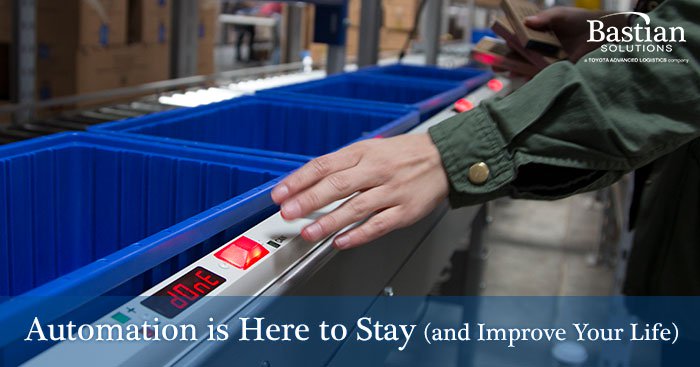
Automation is Here to Stay (and Improve Your Life)
Blake Bearden | 21 November 2019
I often get asked about automation’s effects on employment. It’s a hard reality, but many companies look at a reduction in headcount to cost justify a project, though that mentality can often be short-sided.
Recently, I was meeting with a client to discuss an automation project. Towards the end of the meeting he made it a point to say “please don’t waste your time focusing on trying to reduce my warehouse staff with this project, it’s not my concern at all.” The client, a 3PL, has traditionally operated in a fully manual environment and is eager to pursue automation, but not at the expense of eliminating employees. Instead, his focus was on the pursuit of automation to address their productivity and drive it to new levels. In doing so, the 3PL can focus on gaining new clients to further drive revenue growth.
Much as they do on other topics, the media tend to focus on the negatives of implementing automation. They latch onto specific instances where companies automated and eliminated X% of their employees. What they don't understand is that automation causes redeployment, not unemployment. They fail to recognize those who would have been jobless had it not been for the development of new forms of technology and automation.
Though there is no guarantee of what the future holds, consider some lessons from history in which the implementation of automation improved the quality of our lives while at the same time serving as a conduit for job creation.
Only a century ago, 50 out of every 100 workers toiled on farms to ensure our nation had a sufficient supply of food1. In those days, only three out of 100 workers were employed in educational, medical, recreational or other service careers that contribute to the richer, fuller, healthier lives we enjoy today. Thanks to technological developments such as the tractor and the combine, the number of people working under tough conditions in the field has been reduced to one-sixth, while the number of people employed in life-enriching occupations increased fivefold1. These leaps forward in productivity, aided by automation that often temporarily displaces workers, have enabled all of us to live much richer lives.
Anyone fearful of automation should also stop to consider that were it not for advances in technology over the past decade, real wage levels would be lower by about $8/hr ($0.20/hour) today1. Automation in industry increases worker productivity, which means that the same amount of output could be produced by fewer workers. However, more productive workers also earn higher wages, and since lower production costs translate to lower prices and more output demanded - the result is increased employment.
Henry Ford’s creation of the automobile assembly line in Highland Park, Michigan in 1913 forever changed the lives of his employees. Prior to the automated production line, laborers required over 12 hours to build a single car. The first model T had a cost to the consumer of $850, or about $21,000 in today’s dollars. While cheap, Ford wanted to manufacture more affordable cars for everyone. The automated production line cut down the time required to produce a car down to 93 minutes and would drop the price of the Model T down to just $260 ($3,500 in today’s currency).
The added benefits of automation reduced the workday from nine hours down to eight hours, and while hours were cut, workers did not suffer from lower wages. Instead, Ford nearly doubled the existing standard wage in the industry and began paying his workers $5 a day. Ford’s plan paid off as his workers were able to use some of their pay increases to purchase their own Model Ts2.
The majority of people reading this article may recall in the 1970's and 1980's when automated teller machines (ATMs) started popping up around banks and businesses. At the time, people were worried that these machines would eliminate the need for bank tellers. Quite the contrary, the number of bank tellers continued to rise well into the 2000's because the ATM made it cheaper to open new bank branches. This advancement also improved the lives of bank tellers, reducing the need to count and dispense cash and instead allowed them to focus on more value-added tasks such as selling new financial products and providing advanced levels of customer service.
The Bureau of Labor Statistics has found that the average productivity growth since the Great Recession ended in 2007 has been the slowest of any long economic expansion of the post-World War II era, despite advancements in technology. And despite the fact that productivity growth has increased over the past two years, unemployment has remained at historical lows3.
As the above history lessons reveal, automation has not eliminated jobs. Granted, it has caused displacement of workers, but with the right training and skillsets, those workers have gone on to higher wage opportunities with higher levels of personal fulfillment. While everyone hears about robots taking over the world, soft skills, decision-making and human dexterity will prevent the robots from taking over jobs.
References:
1. ”Don’t Fear Automation…fear the minimum wage” Brozen, 5/12/1965
2. “Henry Ford and the Auto Assembly Line” Goss, 7/24/2019
3. “End the ‘Robots are Coming for Your Job’ Panic” ehrer, 9/4/2019
Blake Bearden is a District Director with Bastian Solutions and works out of the greater Los Angeles area office. He graduated from the United States Air Force Academy with a degree in human factors engineering and has an MBA from Embry-Riddle Aeronautical University. Blake has experience with automation across a range of industries including 3PL, retail distribution, manufacturing, food and beverage, and e-commerce and omni-channel fulfillment.
Comments
Natalie Hogan says:
4/15/2020 03:47 PM
Leave a Reply
Your email address will not be published.
Comment
Thank you for your comment.